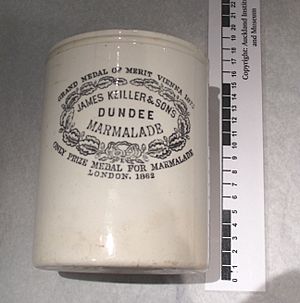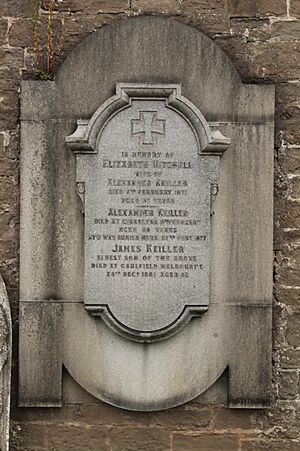Keiller's marmalade facts for kids
| Type | Marmalade |
|---|---|
| Place of origin | Scotland |
| Region or state | Dundee |
| Created by | Janet Keiller |
| Main ingredients | Oranges |
Keiller's marmalade is a famous type of marmalade that started in Dundee, Scotland. It's named after James and Janet Keiller, who are thought to have created the first widely sold marmalade brand in Great Britain. Their company, James Keiller & Son, became very well-known in the 1700s and 1800s.
Contents
The Sweet Story of Keiller's Marmalade
A Stormy Start?
There's a popular story about how Keiller's marmalade began. In the 1700s, a Spanish ship carrying Seville oranges was caught in a big storm. It had to stop in Dundee, Scotland, for safety.
The oranges on the ship were not very fresh because of the delay. James Keiller bought the oranges for a very low price. His mother, Janet Keiller, then used these bitter oranges. She boiled them with sugar to make a large amount of orange marmalade. This is the legend of how it all started!
The Real Invention
While the storm story is fun, Janet Keiller did not invent marmalade. Marmalade had been around in Spain and Portugal since the 1400s. There was even a Scottish recipe for orange marmalade from 1736.
Janet Keiller's real contribution came in 1797. She changed the recipe by adding thin strips of orange peel. This created what we now call "chip" marmalade. People thought the peel helped with digestion.
She also changed the marmalade from a solid block, like a quince jelly, to a soft, spreadable form. This made it perfect for putting on toast, especially for breakfast.
Mother and Son, Not a Couple
It's important to know that James and Janet Keiller were mother and son, not a married couple. James Keiller was single when the marmalade story began. The ship's cargo was probably just a few boxes of Seville oranges. These oranges were often used for medicine or in special recipes, not usually eaten fresh.
The word "marmalade" comes from the Portuguese word "marmelo," which means quince. Quince was a fruit used to make a similar preserve with thin bits of peel. The Keillers' special touch was adding those bits of orange peel. This is still a key part of Seville orange marmalades today.
Growing the Business
For a long time, the Keiller family's main business was running a grocery store. Marmalade was only a small part of their sales in 1833.
James Keiller passed away in 1839. His wife, Margaret, and son, Alexander Keiller, continued the business. In 1840, they opened a new shop in Dundee and also had a small marmalade factory. The first commercial marmalade brand and factory started in 1797.
In 1828, James Keiller's son, James Junior, joined the company. This is when the business became James Keiller and Son.
Expanding Across the World
The company grew a lot in the 1800s. In 1859, they built a factory in Guernsey. This helped them avoid a sugar tax in mainland Britain. It also helped them expand their business in southern England.
Later, in 1888, after the sugar tax was removed, they opened a factory in London. By the late 1800s, Keiller's marmalade was being shipped all over the world! It went as far as Australia, New Zealand, South Africa, India, and China.
John Mitchell Keiller, Alexander's son, led much of this growth. He took over the company in 1877. By 1867, marmalade became the company's most important product. They also worked hard to promote it in British colonies.
In 1876, when Britain started registering trademarks, Keiller's Dundee Orange Marmalade was one of the first brands to be officially protected. The company is also believed to have been the first to sell Dundee cake commercially.
Changes Over Time
In the 1920s, a company called Crosse & Blackwell bought Keiller's. After this, Keiller's started making many different sweets, preserves, and cakes.
Keiller's was sold several more times after that. Eventually, it became part of another Scottish company called Robertson's. Today, Keiller's marmalade is made by the Hain Celestial Group, but it's mostly for export to other countries. The original company stopped existing in 1992.
Famous Family Members
Janet Keiller had some famous descendants. One of her great-great-great grandsons was Alexander Keiller, a well-known archaeologist. Another descendant, her great-great-great-great grandson, is the British TV presenter Monty Don.
James and Janet Keiller are buried in the Howff Cemetery in central Dundee. John Mitchell Keiller is buried in the Western Cemetery, Dundee.





